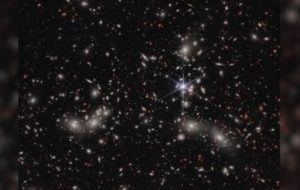
Most galaxies exist in groups or clusters with dozens or hundreds of members, and these cluster galaxies are all in constant motion, pulled and twisted by their neighbour’s gravity.
Galaxies exist in the vastness of space, consisting of various celestial objects such as stars, clouds of dust, and gas, all of which are bound together by gravity. These galaxy clusters are the largest objects in the Universe bound by gravity and astronomers can use them to measure important cosmological properties, according to NASA.
Today’s NASAAstronomy Picture of the Day is a snapshot of Abell 2744, also known as the Pandora’s Cluster of galaxies which is located about 4 billion light-years away towards the constellation of Sculptor. This galaxy cluster formed when four smaller galaxy clusters piled up nearly 350 million years ago, according to NASA. Shockingly, the galaxies in this cluster only account for 5 percent of its mass while dark matter inside it accounts for nearly 75 percent!
Tech used to capture the picture
This awesome snapshot was captured by the NIRCam instrument aboard the James Webb Space Telescope (JWST). It is operated by NASA in collaboration with ESA and is used to capture various celestial objects in stunning detail with the help of its suite of highly advanced instruments and cameras.
It also has sophisticated instruments like the Near Infrared Camera (NIRCam) which is the primary camera onboard the telescope. It has three specialized filters and captures images in two different infrared ranges. NIRCam also has coronagraphic and spectroscopic capabilities and is the primary tool for the alignment of the telescope. The space telescope also has Mid-Infrared Instrument (MIRI) and NIRSpec instruments onboard which aid in capturing mesmerizing snapshots of objects in space.
NASA’s description of the picture
This deep field mosaicked image presents a stunning view of galaxy cluster Abell 2744 from the James Webb Space Telescope’s NIRCam. Also dubbed Pandora’s Cluster, Abell 2744 itself appears to be a ponderous merger of three different massive galaxy clusters some 3.5 billion light-years away toward the constellation Sculptor. Dominated by dark matter, the mega-cluster warps and distorts the fabric of spacetime, gravitationally lensing even more distant objects.
Redder than the Pandora cluster galaxies many of the lensed sources are very distant galaxies in the early Universe, stretched and distorted into arcs. Of course distinctive diffraction spikes mark foreground Milky Way stars. At the Pandora Cluster’s estimated distance this cosmic box spans about 6 million light-years. But don’t panic. You can explore the tantalizing region in a 2 minute video tour




 Driving Naari Programme launched in Chandigarh
Driving Naari Programme launched in Chandigarh






























